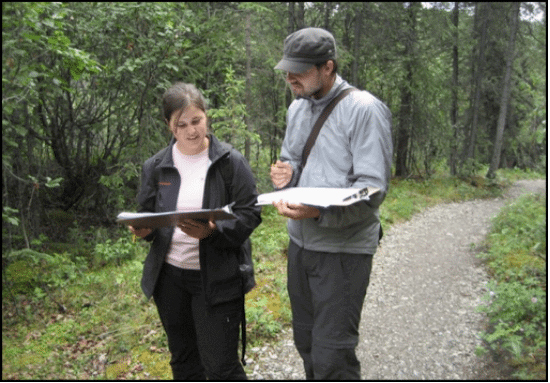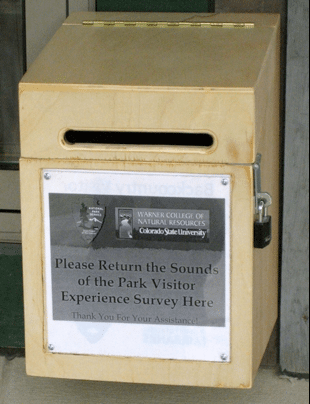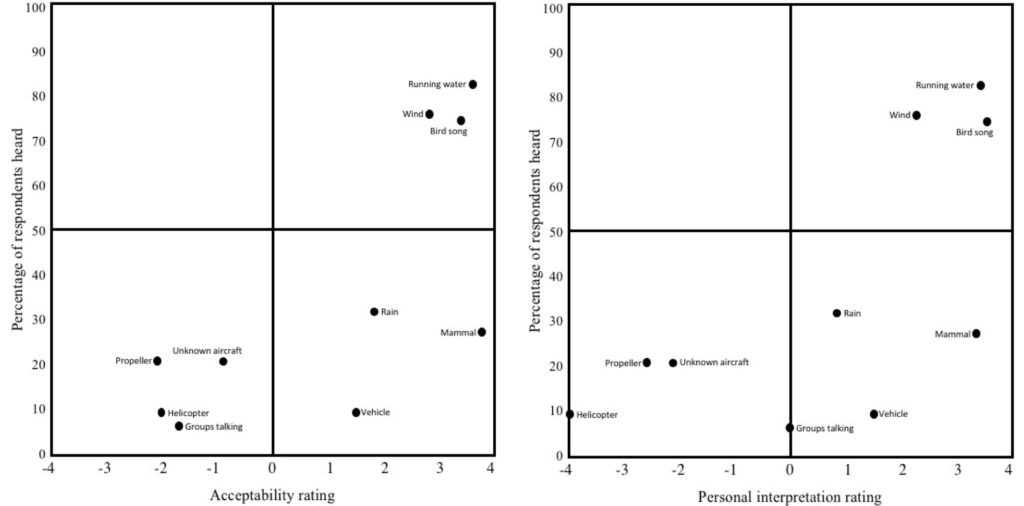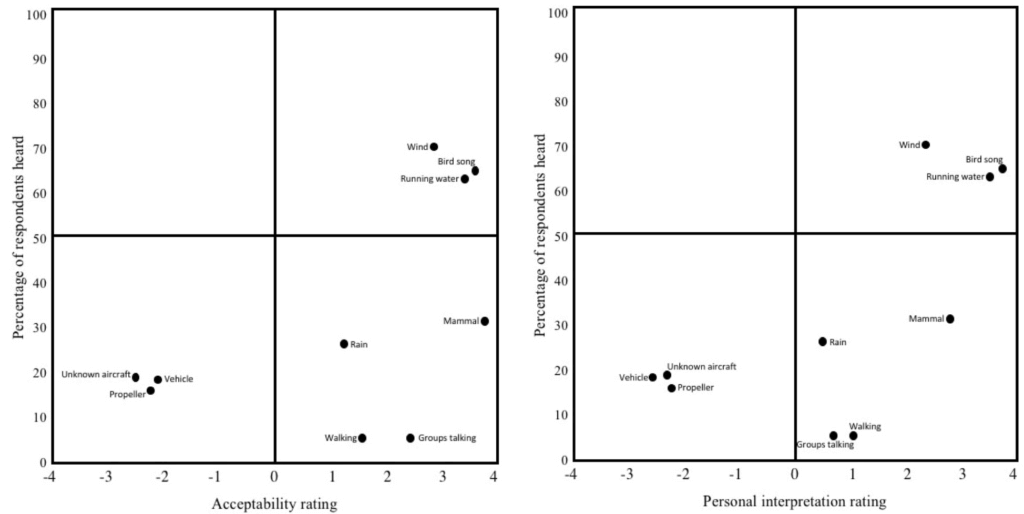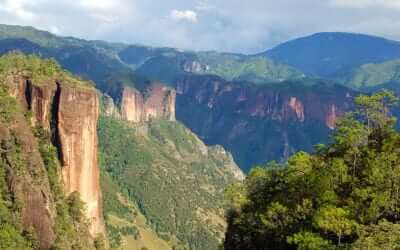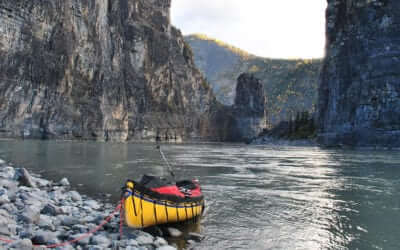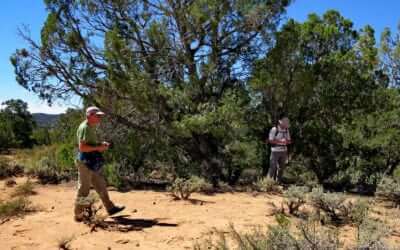© Hari Nandakumar
Visitor Experiences of Wilderness Soundscapes in Denali National Park and Preserve
Stewardship
August 2018 | Volume 24, Number 2
PEER REVIEWED
ABSTRACT Denali National Park and Preserve (DNPP), home to 6 million acres (2,428,114 ha) of land protected as wilderness, has collected a variety of biophysical acoustic data related to a backcountry management plan. However, very little is known about visitor experience related to sounds in the DNPP wilderness. This research explores wilderness users’ sound-related motivations for visiting DNPP and conducts listening activities to help managers develop indicators related to quality soundscape experiences. Sound-related experiences were motivations for a majority of DNPP wilderness visitors. In addition, aircraft noise (e.g., propellers, helicopters, jets) emerged as a potential indictor for understanding the quality of visitor wilderness experiences. Future research should focus on further implementing Management By Objectives frameworks to develop thresholds, monitoring conditions, and implementing management actions as needed to protect the wilderness soundscapes of DNPP.
Natural sounds and ambient quiet are critical components to the quality of visitor experiences in wilderness areas (Pilcher, Newman, Manning 2009; Mace, Bell, and Loomis 1999). However, anthropogenic (human-caused) noise is increasingly present in wilderness. This anthropogenic noise pollution masks natural sounds and has the potential to detract from quality visitor experiences in wilderness settings (Francis et al. 2017; Pilcher et al. 2009). Managers need science-based information related to soundscapes to make decisions about the protection of this valued resource.
Denali National Park and Preserve (DNPP) has 2 million acres (809,371 ha) of designated wilderness and 4 million acres (1,618,743 ha) of land managed as wilderness for a combined 6 million acres (2,428,114 ha) of land protected as wilderness (NPS 2018a). However, human-caused noise is increasingly impacting this vast wilderness (NPS 2018b). In response to this, managers at DNPP have collected an assortment of biophysical acoustic data related to a backcountry management (NPS 2006). Although some social science research exists related to acoustics and mountaineers in DNPP (Taff, Weinzimmer, and Newman 2015), very little is known about how anthropogenic sounds are impacting other wilderness experiences at DNPP. To help managers of DNPP better understand the visitor experience of wilderness soundscapes, we surveyed wilderness users in there. This included samples of wilderness day users at two locations as well as overnight users at two locations. From this research, managers will have a better understanding of the role of sounds in the wilderness experience in DNPP. Specifically, this research can be used to help inform a variety of indicators and thresholds of quality to help protect soundscape resources in the wilderness of DNPP (Pilcher et al. 2009).
Soundscapes Benefits and Management
Soundscapes are defined as all the sounds in a designated area at a specified time (Miller, Hallo, Sharp, Powell, and Lanham 2014; Pijanowksi, Farina, Gage, Dumyahn, and Krause 2011). Recent research has affirmed the importance of natural sounds to both ecological and social well-being. Ecologically, unpolluted natural soundscapes contribute to animal abundance (Bayne, Habib, and Boutin 2008) as well as ecological functions such as vocalizations, foraging, and movement (Francis and Barber 2013). Socially, natural sounds provide a variety of psychological human benefits. For instance, natural sounds help humans improve their mood states and recover from stress (Benfield et al. 2014). In addition, people exposed to natural sounds perform better on mental tasks, which shows the ability of natural sounds to provide cognitive restoration (Abbott et al. 2016). Finally, natural sounds are important to a variety of visitor experiences in protected areas, including birding (Miller et al. 2014), frontcountry use (Pilcher et al. 2009), and wilderness use (Freimund, Peel, Bradybaugh, and Manning 2003; Freimund, Sacklin, Patterson, Bosak, and Saxen 2011; Manning and Hallo 2010).
Management By Objectives (MBO) frameworks use indicators and thresholds to understand the quality of visitor experiences and have been effective in maintaining and/or improving quality visitor experiences related to sounds (Pilcher et al. 2009; Stack, Newman, Manning, and Fristrup 2011). Indicators are specific, measurable, quantifiable, and reliable variables related to an experience, and thresholds are the minimum level of acceptable conditions of an indicator. For instance, the number of people at one time may be an indicator of crowding. There are several existing MBO frameworks that can be used, including the Visitor Experience and Resource Protection (VERP) (Hof and Lime 1997), Limits of Acceptable Change (LAC) (Stankey, Cole, Lucas, Peterson, and Frissell 1985), and the newest, Interagency Visitor Use Management (IVUM) (IVUMC 2016) framework. All MBO approaches contain five distinct steps: (1) establishing broad, narrative management objectives that specify conditions and experiences to be maintained; (2) identifying indicators and thresholds related to the objectives; (3) monitoring indicators to understand conditions; (4) implementing management actions; and (5) repeating steps three through five to evaluate conditions and adapt if needed. Our principal interests in this study were twofold: to collect information about sound-related motivations for visiting DNPP, and to conduct a listening activity to help develop indicators of quality for wilderness soundscape experiences. From this process, managers at DNPP can be more informed about selecting quality indicators related to soundscapes to wilderness experiences.
Methods
Three different locations were selected for sampling within DNPP: (1) the Triple Lakes Trail (TL) area, the McKinley Bar Trail (MB) area, and the Backcountry Information Center (BIC). These areas were selected because they all provide access to wilderness, are popular, and would provide contact with both day and overnight users of wilderness. At both TL and MB, we used a systematic sampling approach, whereas at BIC we used a census approach due to lower use numbers. Systematic refers to sampling a portion of overall visitors by intercepting every nth visitor (e.g., every third visitor, or some other chosen number). Census refers to sampling every visitor. At all locations, a trained researcher intercepted visitors for sampling. If groups were contacted, the person with the most recent birthday was asked to participate to randomize the selection. Visitors completed the questionnaires while in DNPP. Response rates and sampling dates varied by location (Table 1).
We used a 5-point Likert-scale (1=not at all important, 5=extremely important) to evaluate the importance of two sound-related motivations for visiting DNPP. The statements visitors responded to on the scale were (1) experiencing the sounds of nature, and (2) enjoying peace and quiet.
For developing indicators related to quality soundscape experiences, we conducted two different forms of a listening activity. For visitors intercepted at TL and MB, we asked respondents to listen to the sounds around them for three minutes. After this time, they indicated what sounds were heard, and how they felt about those sounds regarding their acceptability and their personal interpretation via a paper questionnaire (Figure 1). This was only done once per respondent. Acceptability and personal interpretation were considered different concepts. For instance, the sound of an insect may be considered acceptable in DNPP, but it can also be interpreted as annoying. Most acoustic indicators should generally be both unacceptable and annoying. Acceptability was measured on a 9-point scale where -4=very unacceptable and 4=very acceptable. Personal meaning was measured in a similar way, where -4=very annoying and 4=very pleasing. Although respondents reported hearing more than 25 sounds, for simplification, only the top 5 anthropogenic sounds and the top 5 natural sounds from the listening activities are included in the analysis.
At BIC, we asked one departing backpacker per group (n=150) to conduct a self-directed listening activity while in the backcountry at two different locations: while in camp and during a hiking break. We received 57 completed surveys from this, resulting in a response rate of 38%. We assume this response rate to be lower because respondents at the BIC had to carry their survey with them during their travels, and then remember to deposit it upon return (Figure 2). Respondents listened at each location for three minutes, and then recorded their responses on the same scales as the visitors at TL and MB did (e.g., both acceptability and personal meaning). Respondents were also asked to indicate the coordinates or backcountry zones and times of where/when they listened. For the listening activity, only the top five anthropogenic sounds and the top five natural sounds are included for analysis. We also asked all visitors at the BIC to complete a demographics questionnaire immediately upon intercept at the BIC (n=293; response rate=100%). Demographics in the results for BIC respondents are derived from this larger group of BIC visitors. We did not ask the 150 listening activity respondents to complete additional demographic questions to reduce redundancy and visitor burden.
Results
Sample Characteristics
At TL, about 65% of respondents’ length of visit was two to three days. Seventy percent of respondents were with their families. Two primary activities were reported, with 82% of respondents saying their primary activity was day hiking, and 18% of respondents saying their primary activity was wildlife viewing. At MB, about 54% of respondents’ length of visit was two to three days. Fifty-two percent of respondents were with their families. Four primary activities were reported: 82% of respondents said their primary activity was day hiking, 21% said they were camping, 15% of respondents said their primary activity was wildlife viewing, and 6% said they were participating in “other” activities. For respondents at BIC, 57% of respondents were with friends, and 29% were with their families. Additional visitor characteristics are displayed below in Table 2.
Soundscape Motivations
Across all three sites and both measures, respondents rated soundscape motivations from very important (M=4) to extremely important (M=5) (Table 3). At TL, 84% of respondents found experiencing the sounds of nature to be very or extremely important motivations for visiting DNPP, and 84% of respondents also found enjoying peace and quiet to be very important or extremely important motivations for visiting DNPP. MB respondents showed that 71% found experiencing the sounds of nature to be very or extremely important motivations for visiting DNPP, and 78% found enjoying peace and quiet to be very or extremely important motivations for visiting DNP. At BIC, 67% of respondents stated that experiencing the sounds of nature was a very or extremely important motivation for visiting DNPP, and 82% of respondents found enjoying peace and quiet to be very or extremely important motivations for visiting DNPP.
Listening Activity to Develop Indicators of Wilderness Soundscape Quality
Plots for both acceptability and personal meaning related to the sounds respondents heard during their listening activities display the data from all locations (Figures 3, 4, 5, and 6). As in previous research (Pilcher et al. 2009), potential indicators are identified by examining the plots for sounds that detract from the visitor experience (e.g., are annoying and unacceptable). As found in previous research exploring sounds and visitors (Miller et al. 2014; Pilcher et al. 2009), anthropogenic sounds were largely considered unacceptable and annoying. Conversely, natural sounds were largely considered acceptable and pleasing, with a few exceptions. For instance, insects, wind, and rain were often considered less acceptable and less pleasing than other natural sounds such as running water, birdsong, and mammals. Overall, natural sounds (e.g., running water, birdsong, mammals, etc.) were much more prevalent when compared to human-caused sounds (e.g., shuttles, vehicles, voices, etc.).
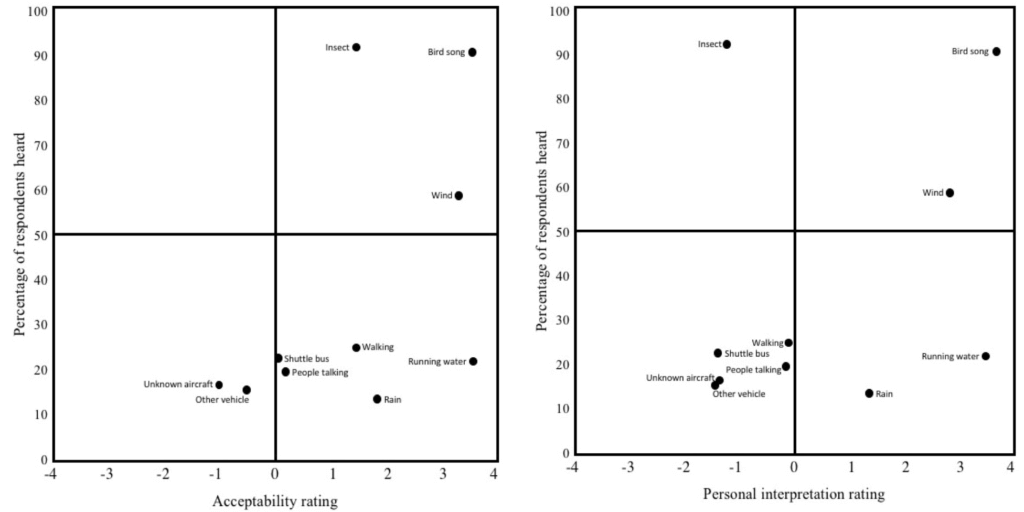
Figure 4 – Acceptability and personal interpretation of sounds plots for the McKinley Bar Trail area.
Discussion and Management Implications
The purpose of this research was to develop a better understanding of the social role that sounds play in the wilderness experience of DNPP, and to help inform managers of potential indicators for future use in developing thresholds related to wilderness soundscape quality. First, a large majority (at least 67%) of respondents among all sampling locations said sound-related motivations for visiting DNPP were very or extremely important, indicating that quiet, natural soundscapes are an important part of wilderness visitor experiences. Visitors come to DNPP to experience these wild soundscapes, particularly the peace, quiet, and natural sounds of the area. Second, this research helps inform managers regarding indicators related to quality wilderness soundscapes. Wilderness users evaluated human-caused sounds as largely less acceptable and less pleasing than natural sounds. This was particularly true for anthropogenic sounds that were the result of mechanized aircraft, such as helicopters, propellers, and unknown aircraft. Because mechanized aircraft sounds were consistently some of the most annoying and unacceptable sounds evaluated by visitors, DNPP managers should focus on them as indicators of quality wilderness soundscape experiences.
Currently, research on soundscapes in DNPP is ongoing. Informed by the results from the listening activities, a necessary next step in any MBO framework (e.g., VERP, LAC, IVUM, etc.) is to set standards/thresholds for mechanized aircraft sounds. In this process, managers begin to understand how much noise from mechanized aircraft is acceptable before wilderness visitor experience is degraded. Further monitoring and, if necessary, the implementation of management actions will complete the establishment of an MBO framework for wilderness soundscape experiences in DNPP. An example of where an MBO framework was successfully applied to manage human-caused sound is in Muir Woods National Monument. This research found that human-caused sounds, mostly from loud voices, was above acceptable thresholds and that information was able to reduce visitor-caused sound (Manning et al. 2010; Marin et al. 2011; Pilcher et al. 2009)
Because mechanized aircraft sounds were consistently some of the most annoying and unacceptable sounds evaluated by visitors, DNPP managers should focus on them as indicators of quality wilderness soundscape experiences.
This research adds to a body of literature on soundscapes that shows the importance of human-caused sounds as indicators of visitor experiences in protected areas such as wilderness (Freimund et al. 2003; Miller et al. 2014; Park, Lawson, Kaliski, Newman, and Gibson 2010; Pilcher et al. 2009; Rapoza, Sudderth, and Lewis 2015; Stack et al. 2011; Taff et al. 2014). However, a key takeaway from this collective research is that site-specific context matters for developing indicators. The management of human-caused noise will vary by site, and key indicators may include aircraft (Taff et al. 2014), personal vehicles (Park et al. 2010), or human voices (Pilcher et al. 2009; Stack et al. 2011). Revisiting this current research, aircraft noises were the most annoying and unacceptable to visitors at DNPP, and people talking was relatively more acceptable and pleasant. This is different than the study mentioned at Muir Woods National Monument, where people talking was the sound variable that was most annoying (Pilcher et al. 2009). Listening activities such as the one used in this current research provide a science-based way for managers to develop indicators that will be effective for managing visitor soundscape experiences in the context of their sites. However, some sounds that detract from the visitor experience may be difficult to eliminate from an area. For instance, in Sequoia National Park, military overflights detract from the visitor experience, but are not preventable by park managers (Taff et al. 2014). In this instance, information about the overflights increased visitor acceptability of overflight sounds (Taff et al. 2014). Similar educational methods could be used to improve visitor experiences when the detracting sounds cannot be reduced or eliminated.
This research has several notable limitations. First, there may be some unknown differences between overnight and day users of wilderness due to the differences in the listening activity (e.g., self-directed versus in-person). Future research may want to simply provide self-directed listening activities for all participants. A broader limitation of soundscape research in wilderness and protected area settings is that it has been almost completely developed in the national parks of the United States of America. This ignores the reality that different cultures have different perceptions of wildness and nature (Miller, Freimund, and Blackford 2018). We currently have very little information on soundscape management outside of Europe and the United States. Future research should focus on understanding soundscape resources in a global context. This should include the exploration of concepts such as motivations, values, and benefits of natural sounds in wilderness and protected areas that have created such a focus on soundscape management in the United States (Francis et al. 2017; Miller 2008; Newman, Manning, and Trevino 2010). In addition, managers of international protected areas should apply similar MBO frameworks to explore the role of sounds to visitors in contexts that are different from those in the United States.
ZACH MILLER is a post-doctoral research associate at Penn State. His research focuses on park and conservation area management, visitor use management, human-wildlife relationships, and environmental communication; email: zdm9@psu.edu
B. DERRICK TAFF is an assistant professor in the Recreation, Park and Tourism Management Department at Penn State University; email: bdt3@psu.edu
PETER NEWMAN is professor and head of the Department of Recreation, Parks and Tourism Management at Penn State University and co-leads the Protected Areas Research Collaborative (PARC).
References
Abbott, L. A., B. D. Taff, P. Newman, J. A. Benfield, and A. J. Mowen. 2016. Influence of natural sounds on restoration. Journal of Park and Recreation Administration 34: 5–15.
Bayne, E. M., L. Habib, and S. Boutin. 2008. Impacts of chronic anthropogenic noise exposure for terrestrial organisms. Conservation Biology 22: 1186–1193.
Benfield, J. A., B. D. Taff, P. Newman, and J. Smyth. 2014. Natural sound facilitates mood recovery from stress. Ecopsychology 6: 183–188.
Francis, C. D., and J. R. Barber. 2013. A framework for understanding noise impacts on wildlife: An urgent conservation priority. Frontiers in Ecology and the Environment 11: 301–313.
Francis, C. D., P. Newman, B. D. Taff, C. White, C. Monz, M. Levenhagen, … J. R. Barber. 2017. Acoustic environments matter: Synergistic benefits to humans and ecological communities. Journal of Environmental Management (December): 245–254.
Freimund, W., S. Peel, J. Bradybaugh, and R. E. Manning. 2003. The wilderness experience as purported by planning compared with that of visitors to Zion National Park. In Proceedings, George Wright Society Annual Conference (pp. 276–280). Hancock, MI: George Wright Society.
Freimund, W., J. Sacklin, M. Patterson, K. Bosak, and S. Saxen. 2011. Soundscapes and the winter visitor experience. Yellowstone Science 19(2): 6–13.
Hof, M., and D. W. Lime. 1997. Visitor experience and resource protection frame-work in the national park system: Rationale, current status, and future direction. In Proceedings – Limits of Acceptable Change and Related Planning Processes: Progress and Future Directions, comp. Stephen F. McCool and David N. Cole (pp. 26–29). Ogden, UT: US Department of Agriculture–Forest Service, Rocky Mountain Research Station.
IVUMC (Interagency Visitor Use Management Council). 2016. The Interagency Visitor Use Management Council. Retrieved from http://visitorusemanagement.nps.gov.
Mace, B. L., P. A. Bell, and R. J. Loomis. 1999. Aesthetic, affective, and cognitive effects of noise on natural landscape assessment. Society & Natural Resources 12(3): 225–242.
Manning, R. E., and J. C. Hallo. 2010. On the edge, peering in: Defining and managing the near-wilderness experience on the Denali Park Road. International Journal of Wilderness 16(3): 28–34.
Manning, R., P. Newman, K. Fristrup, D. Stack, and E. Pilcher. 2010. A program of research to support management of visitor-caused noise at Muir Woods National Monument. PARKScience 26(3): 54-58.
Marin, L. D., P. Newman, R. Manning, J. J. Vaske, and D. Stack. 2011. Motivation and acceptability norms of human-caused sound in Muir Woods National Monument. Leisure Sciences 33(2): 147–161.
Miller, N. P. 2008. US national parks and management of park soundscapes: A review. Applied Acoustics 69(2): 77–92.
Miller, Z. D., J. C. Hallo, J. L. Sharp, R. B. Powell, and J. D. Lanham. 2014. Birding by Ear: A Study of Recreational Specialization and Soundscape Preference. Human Dimensions of Wildlife 19(6): 498–511.
Miller, Z. D., W. Freimund, and T. Blackford. 2018. Communication perspectives about bison safety in Yellowstone National Park: A comparison of international and North American visitors. Journal of Park and Recreation Administration 36(1): 179-189.
National Park Service. 2018a. Wilderness. Retrieved from https://www.nps.gov/dena/learn/nature/wilderness.htm.
———. 2018b. Soundscapes: What does wilderness sound like? Retrieved from https://www.nps.gov/dena/learn/nature/soundscape.htm.
———. 2006. Denali National Park and Preserve Final Backcountry Management Plan: General Management Plan Amendment and Environmental Impact Statement. Final EIS.
Newman, P., R. E. Manning, and K. Trevino. 2010. From landscapes to soundscapes: Introduction to the special issue. Park Science 26(3): 2–5.
Park, L., S. Lawson, K. Kaliski, P. Newman, and A. Gibson. 2010. Modeling and mapping hikers’ exposure to transportation noise in Rocky Mountain National Park. Park Science 26(3): 1–11.
Pijanowski, B. C., A. Farina, S. H. Gage, S. L. Dumyahn, and B. L. Krause. 2011. What is soundscape ecology? An introduction and overview of an emerging new science. Landscape Ecology 26(9): 1213–1232.
Pilcher, E. J., P. Newman, and R. E. Manning. 2009. Understanding and managing experiential aspects of soundscapes at Muir Woods National Monument. Environmental Management 43: 425–435.
Rapoza, A., E. Sudderth, and K. Lewis. 2015. The relationship between aircraft noise exposure and day-use visitor survey responses in backcountry areas of national parks. Journal of the Acoustical Society of America 138(4): 2090–2105.
Stack, D. W., P. Newman, R. E. Manning, and K. M. Fristrup. 2011. Reducing visitor noise levels at Muir Woods National Monument using experimental management. The Journal of the Acoustical Society of America 129(3): 1375–1380.
Stankey, G. H., D. N. Cole, R. C. Lucas, M. E. Peterson, and S. S. Frissell. 1985. The Limits of Acceptable Change (LAC) System for Wilderness Planning. Ogden, UT: US Department of Agriculture–Forest Service, Intermountain Forest and Range Experiment Station.
Taff, D., P. Newman, S. R. Lawson, A. Bright, L. Marin, A. Gibson, and T. Archie. 2014. The role of messaging on acceptability of military aircraft sounds in Sequoia National Park. Applied Acoustics 84: 122–128.
Taff, B. D., D. Weinzimmer, and P. Newman. 2015. Mountaineers’ Wilderness Experience in Denali National Park and Preserve. International Journal of Wilderness 21(2): 7–15.
Read Next
WILD11: Why China, and Why Now
The 11th World Wilderness Congress (WWC), or WILD11, will convene in China in late 2019. Our China partners have promised exact venue and date for 2019 in September of this year.
Paradigms Lost: A Rumination on the Pursuit of Wildness
Recently, two reissued books from the early 1900s caught my attention. The books are That Summer on the Nahanni 1928: The Journals of Fenley Hunter and Sleeping Island: A Journey to the Edge of the Barrens, by P. G. Downes.
Understanding and Mitigating Wilderness Therapy Impacts: The Grand Staircase-Escalante National Monument Case Study
Studies demonstrate that wilderness therapy programs can be beneficial for participants; however, little research has explored the ecological impacts of these programs.


